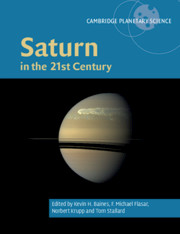Book contents
- Saturn in the 21st Century
- Cambridge Planetary Science
- Saturn in the 21st Century
- Copyright page
- Contents
- Contributors
- Reviewers
- 1 Introduction to Saturn in the 21st Century
- 2 The Origin and Evolution of Saturn, with Exoplanet Perspective
- 3 The Interior of Saturn
- 4 Saturn’s Magnetic Field and Dynamo
- 5 The Mysterious Periodicities of Saturn
- 6 Global Configuration and Seasonal Variations of Saturn’s Magnetosphere
- 7 Saturn’s Aurorae
- 8 Saturn’s Ionosphere
- 9 Saturn’s Variable Thermosphere
- 10 Saturn’s Seasonally Changing Atmosphere
- 11 The Global Atmospheric Circulation of Saturn
- 12 Saturn’s Polar Atmosphere
- 13 The Great Saturn Storm of 2010–2011
- 14 The Future Exploration of Saturn
- Index
- References
8 - Saturn’s Ionosphere
Published online by Cambridge University Press: 13 December 2018
- Saturn in the 21st Century
- Cambridge Planetary Science
- Saturn in the 21st Century
- Copyright page
- Contents
- Contributors
- Reviewers
- 1 Introduction to Saturn in the 21st Century
- 2 The Origin and Evolution of Saturn, with Exoplanet Perspective
- 3 The Interior of Saturn
- 4 Saturn’s Magnetic Field and Dynamo
- 5 The Mysterious Periodicities of Saturn
- 6 Global Configuration and Seasonal Variations of Saturn’s Magnetosphere
- 7 Saturn’s Aurorae
- 8 Saturn’s Ionosphere
- 9 Saturn’s Variable Thermosphere
- 10 Saturn’s Seasonally Changing Atmosphere
- 11 The Global Atmospheric Circulation of Saturn
- 12 Saturn’s Polar Atmosphere
- 13 The Great Saturn Storm of 2010–2011
- 14 The Future Exploration of Saturn
- Index
- References
Summary
This chapter summarizes our current understanding of the ionosphere of Saturn. We give an overview of Saturn ionospheric science from the Voyager era to the present, with a focus on the wealth of new data and discoveries enabled by Cassini, including a massive increase in the number of electron density altitude profiles. We discuss recent ground-based detections of the effect of “ring rain” on Saturn’s ionosphere, and present possible model interpretations of the observations. Finally, we outline current model-data discrepancies and indicate how future observations can help in advancing our understanding of the various controlling physical and chemical processes.
- Type
- Chapter
- Information
- Saturn in the 21st Century , pp. 196 - 223Publisher: Cambridge University PressPrint publication year: 2018
References
- 3
- Cited by



